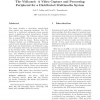Free Online Productivity Tools
i2Speak
i2Symbol
i2OCR
iTex2Img
iWeb2Print
iWeb2Shot
i2Type
iPdf2Split
iPdf2Merge
i2Bopomofo
i2Arabic
i2Style
i2Image
i2PDF
iLatex2Rtf
Sci2ools
MM
1993
ACM
1993
ACM
The Vidboard: A Video Capture and Processing Peripheral for a Distributed Multimedia System
This paper describes a stand-alone network-based video capture and processing peripheral (the Vidboard) for a distributed multimedia system centered around a gigabit-per-second Asynchronous Transfer Mode (ATM) network. The Vidboard captures video from an analog NTSC television source and transmits it to devices within the system. Devices control the Vidboard through a set of ATM protocols. Whereas capture boards typically generate video streams having fixed frame rate characteristics, the Vidboard is capable of decoupling video from the real-time constraints of the television world. This allows easier integration of video into the software environment of computer systems. The Vidboard is based on a front-end framememory processor architecture that is also capable of generating full-motion video streams having a range of presentation (picture size, color space) and network (traffic, pixel packing) characteristics. A series of experiments are presented in which video is transmitted to ...
| Added | 10 Aug 2010 |
| Updated | 10 Aug 2010 |
| Type | Conference |
| Year | 1993 |
| Where | MM |
| Authors | Joel F. Adam, David L. Tennenhouse |
Comments (0)

